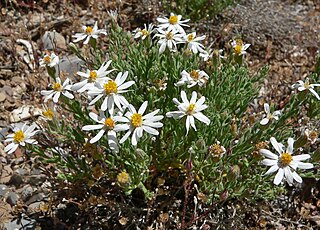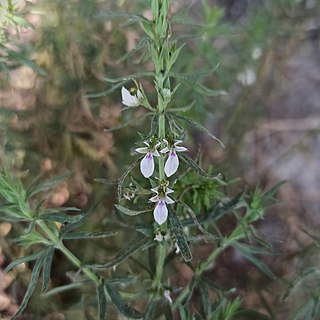
Baccharis pilularis, called coyote brush, chaparral broom, and bush baccharis, is a shrub in the family Asteraceae native to California, Oregon, Washington, and Baja California. There are reports of isolated populations in New Mexico, most likely introduced.

Stephanomeria is a genus of North American plants also known as wirelettuce, belonging to the tribe Cichorieae within the family Asteraceae.

Atriplex confertifolia, the shadscale or spiny saltbush, is a species of evergreen shrub in the family Amaranthaceae, which is native to the western United States and northern Mexico.

Allium cernuum, known as nodding onion or lady's leek, is a perennial plant in the genus Allium. It grows in open areas in North America.

Chaenactis is a genus of plants in the family Asteraceae which are known generally as pincushions and dustymaidens.

Chaetopappa is a genus of plants in the family Asteraceae which are known generally as leastdaisies.

Nymphaea odorata, also known as the American white waterlily, fragrant water-lily, beaver root, fragrant white water lily, white water lily, sweet-scented white water lily, and sweet-scented water lily, is an aquatic plant belonging to the genus Nymphaea. It can commonly be found in shallow lakes, ponds, and permanent slow moving waters throughout North America where it ranges from Central America to northern Canada. It is also reported from Brazil and Guyana.

Cyperus erythrorhizos is a species of sedge known by the common names red-rooted flatsedge or redroot flatsedge. It is found across much of North America from Maine, Ontario and British Columbia south to Tabasco in southern Mexico.

Guardiola is a genus of plants in the family Asteraceae, native to Mexico and the southwestern United States. Members of the genus are subshrubs with simple, opposite leaves and terminal inflorescences.

Allolepis is a genus of North American plants in the grass family.
Adenothamnus is a genus of flowering plants in the family Asteraceae described as a genus in 1935.

Teucrium cubense is a species of flowering plant in the mint family known by the common names small coastal germander and dwarf germander. It is native to a section of the Americas that includes the southwestern - south-central United States, parts of the Caribbean, Mexico, Costa Rica, and southern South America. In general, the plant has lobed leaves and a flower corolla with a broad lower lobe and smaller lateral lobes. The flower may be white or blue-tinged with purple speckles.
Quercus intricata, common name dwarf oak, intricate oak or Coahuila scrub oak, is a plant species native to northern Mexico and western Texas.

Ambrosia salsola, commonly called cheesebush, winged ragweed, burrobush, white burrobrush, and desert pearl, is a species of perennial shrub in the family Asteraceae native to deserts of the southwestern United States and northwestern Mexico.

Phaulothamnus is a genus of plants formerly included in the family Phytolaccaceae but now considered a part of the Achatocarpaceae.
Iresine heterophylla, or Standley's bloodleaf, is a plant species native to the southwestern United States and also to Mexico. It has been collected from Arizona, New Mexico, Texas, Chihuahua, Sonora, Durango, Coahuila, Nuevo León, Campeche and Tabasco.
Acleisanthes parvifolia, common names littleleaf moonpod and Big Bend trumpets, is a plant species native to northeastern Chihuahua, Mexico, and western Texas, United States. In Texas, is known from only 4 counties: Culberson, Hudspeth, Brewster and Presidio. Some of the populations are situated inside Big Bend National Park, others within Guadalupe Mountains National Park.

Hesperaloe funifera is a plant species native to Texas and northern Mexico, but sometimes cultivated as an ornamental elsewhere.

Euphrosyne dealbata, commonly known as copperweed or woolly marsh elder, is a species of plant in the family Asteraceae. It is found in western North America where it is native to northern Mexico, and the south-western United States.

Ambrosia monogyra is a species of flowering plant in the sunflower family commonly known as the singlewhorl burrobrush, leafy burrobush, slender burrobush, and desert fragrance. Ambrosia monogyra is native to North America and is typically found in canyons, desert washes, and ravines throughout arid parts of the southwestern United States and northern Mexico. This species has green, threadlike leaves that emit a distinctive odor when crushed, and flowers from August to November. The fruits have distinctive wings in their middle that aid in dispersion through wind and water.















